by Silvia Parmeggiani, Community Officer, Belize
Despite the early start, the full sun was already beating down on us as we drive down the dusty road from Sarteneja, on our way to Belize City. Belize is a country of many cultures, with the mestizo (Spanish) dominance in the north very different to the more Caribbean feel of the southern coast; this difference was very much reflected when changing buses in Belize City as the bus we boarded was painted in bright Rasta colours.
Our final destination was Placencia, a village not much bigger than Sarteneja, but its wide sandy beaches and paved roads (and a little help from some good marketing) have transformed this small fishing village into a busy and desirable tourist destination. It’s the Monday in the week leading up to LobsterFest 2014 and preparations for the weekend are already well under way with tents being erected on the beach, and banners advertising the event filling the streets. We are here to prepare for the 4th Lionfish Slayers Tournament, which is held during LobsterFest.
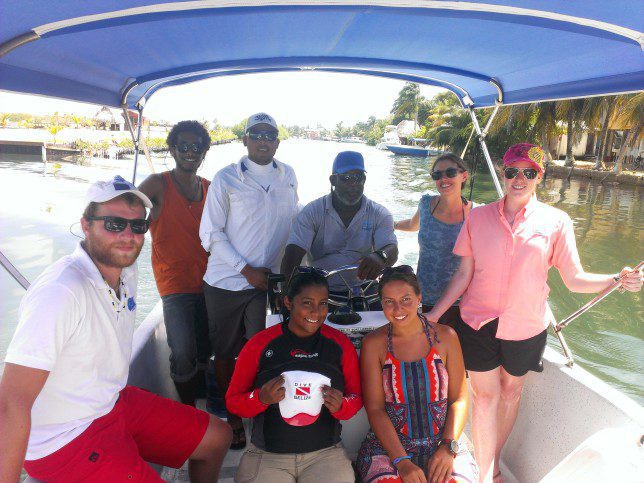
The international survey team led by BV’s Jen and Masha, SEA’s Omar, and SEA interns Ruth (from the University of Belize), Tyler, Omar, and Megan (from Texas A&M University)
Celebrating the opening of lobster season is a perfect excuse to promote this beautiful location, and for NGOs it is a perfect occasion to raise awareness of the many threats the unique, but fragile Belizean ecosystems face. Since 2011 the Southern Environmental Association (SEA) has organised a lionfish culling tournament, and since 2012 Blue Ventures has been helping SEA by coordinating the science and outreach associated with the event. Oceana Belize is also supporting the lionfish tournament, for the second year running, as part of their “protect the babies” juvenile fish campaign.
The days leading to the tournament are hard work; on Wednesday the survey team set out to assess the areas in which the lionfish will be culled, in order to get an estimate of the lionfish population prior the tournament. The surveys will be repeated two days and a month after the tournament, measuring the effectiveness of the tournament on reducing the lionfish population and also to study the recovery rate.
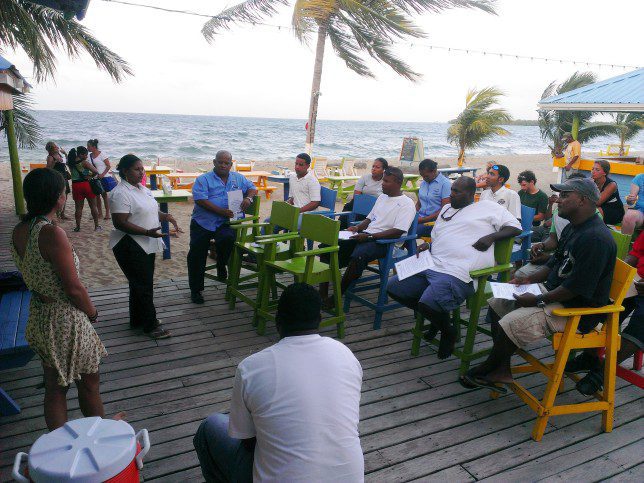
Abigail and Mr Garbutt of SEA makes sure the participants know the rules of the tournament
As the group comes back with the precious data, the rest of us are already preparing for the participating teams’ welcome event, hosted by one of Placencia’s famous beach bars: the Tipsy Tuna. Here we greet the teams and we make sure all are registered and are aware of the rules, and captain of the ship Jen gives a presentation about the lionfish invasion in order to inform the participants about the importance of the event. These lionfish culls contribute to the removal effort of the lionfish, and lessen the effects of this voracious predator within the no-take-zones of protected areas where normal fishing is prohibited.
The participating teams head off early in the morning. On every boat a member of the survey team is in charge of noting the GPS coordinates and number of lionfish removed from each site. This will provide a picture of the removal effort and its impact on population density – linking into the results of SCUBA surveys.
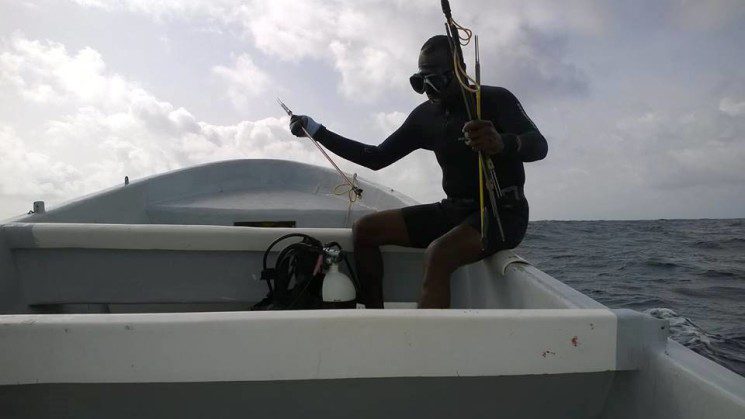
On the Placencia Producers’ Cooperative boat, Elroy, a member of the team, is getting ready to spear some lionfish!
As the boats come back with their catch, a crowd of curious tourists forms around the dock. While the teams proudly show off their coolers full of lionfish, the onlookers ask many questions about these colourful invaders, giving us the opportunity to transform every moment in a way to promote the lionfish market and educate the public. We then start counting the lionfish and it seems like this year the teams are real over-achievers… the final result amounts to a total of 1,057 lionfish culled! This is almost double the result from last year; have our lionfish slayers become masters? Or have the lionfish become more abundant? We hope the first, but with female lionfish capable of producing up to two million eggs per year, it’s more likely the latter.
While the participating divers head home for some well-earned rest, handing us over their catch, the most intense part of the day starts for the tournament’s scientific side. All the lionfish are measured one by one providing data on population size structure that we can compare year to year, as well as enabling us to look at the maturity of the fish and develop estimates for population growth rate. Once all the necessary data is collected the fish pass through Khadija’s (of Kaj Expressions) expert hands as she removes the precious tails for her artistic creations and then go to the cooperative where they will be filleted and kept for sale.
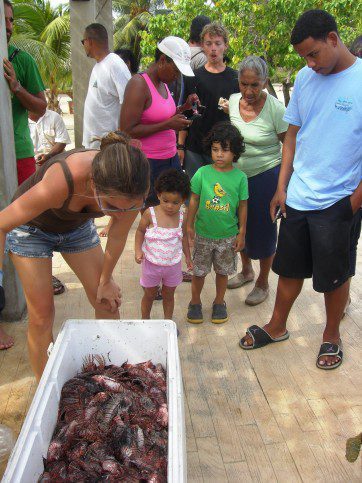
A cooler full of striped and brightly coloured fish cannot but attract attention: every opportunity is useful to raise awareness!
Saturday morning, as the festival opens, we’re back to work. We have set up a booth entirely dedicated to lionfish, where Blue Ventures, SEA and Oceana collaborate to raise awareness both about the biological impacts but also on burgeoning market for lionfish meat and jewellery. We’re kept busy; Omar, now in his role of cook, fries up some battered lionfish for people to taste. At the same time, Megan, Masha and I invite children to play a fishing game, and ask passers-by to test their lionfish knowledge with a short quiz. This is an opportunity for us to survey the general public’s knowledge and the effectiveness of the lionfish social marketing campaigns. In Placencia many restaurants are already selling lionfish and most of the people have some kind of knowledge of the problem, but there is always more to learn!
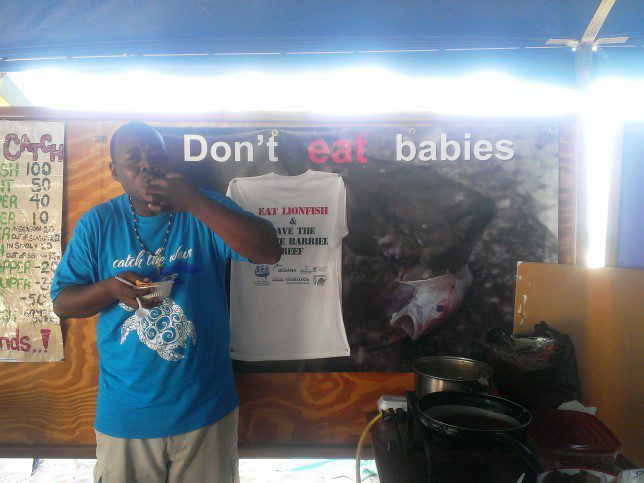
While we advertise different lionfish markets, both using it as food and for jewellery making, Oceana uses this space as an opportunity to promote their campaign against the consumption of juvenile fish
The whole area near our booth is dedicated to conservation groups and the general atmosphere is friendly and cheerful. It is encouraging to meet like-minded people working in various NGOs from all around the country. When children involved in our fishing game ask us why they shouldn’t catch shark, we direct them to our neighbours: the Belize Shark project. For those who ask where they can buy lionfish after having tasted one of Omar’s delicacies we indicate the Placencia Producers Coop on our left.
The presence of so many different conservation organisations is certainly heartening and also a demonstration of how strong Belizeans’ love for the environment is.
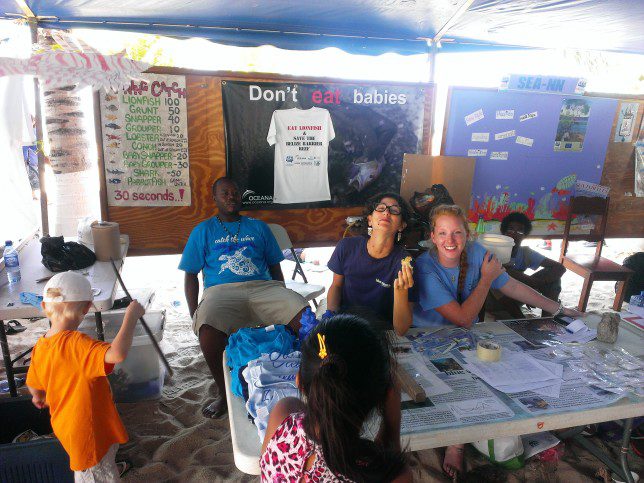
Denroy of Oceana, Megan of SEA and I at our booth, partnerships that make messages stronger and outreach work so much more fun and lively
The tourism industry in Belize is very much centred on the environment and most of the tourists, after having eaten a lobster kebab and bought an artisanal souvenir, are interested in learning about all the different environmental efforts that take place in this amazing country. Joining forces to strengthen positive behaviours and sustainable attitudes is a great way to work for the environment and the interest shown by most is definitely encouraging.
The weekend flew by, and was a big change from the quiet, calm and easy going life of Sarteneja. An enormous thank you goes to SEA and Oceana for their collaboration, to all the volunteers, interns and staff members for helping out in every moment and being such wonderful company at the booth. And a special thanks to Masha, our friend and Blue Ventures ex-volunteer who was more than helpful, very hard working and of great support all the way through!
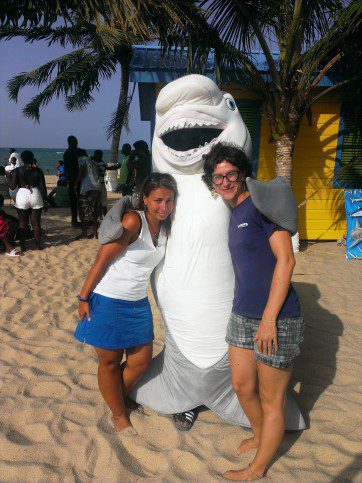
Masha (left) and I with our friend, the shark!

